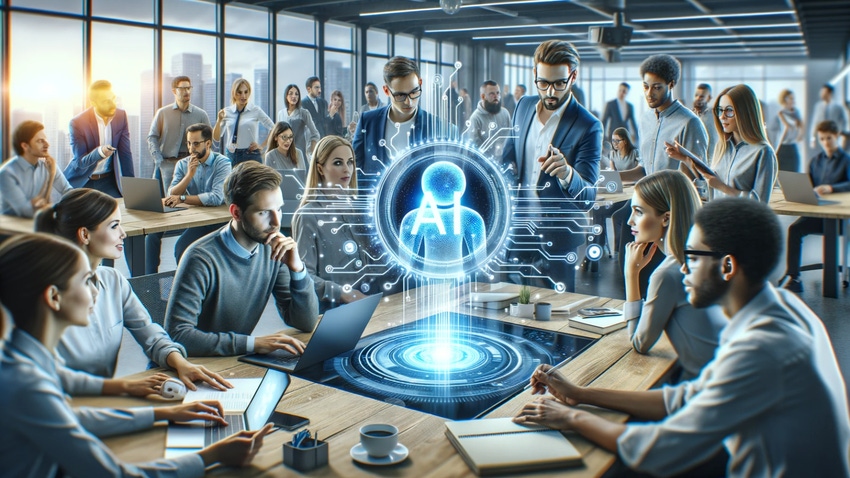Generative AI's Impact on Jobs and Workforce Planning
An opinion piece from a distinguished VP analyst at Gartner, specializing in Human Capital Management (HCM) technologies and strategies

In the fast-evolving realm of technology, few innovations have captured the collective attention as vividly as generative AI. Its potential to reshape industries, redefine roles and revolutionize how we work is a testament to the monumental strides we have taken in the domain of artificial intelligence. As we stand at this technological crossroads, the implications of generative AI on jobs and workforce planning demand our careful attention.
This article delves into the multifaceted effects of generative AI, explores strategic approaches to harness its power, and outlines key considerations for a future where humans and machines collaborate seamlessly.
1. Shifting roles and skillsets: The emergence of a new employment landscape
The integration of generative AI into our work environments heralds a paradigm shift. Tasks and roles that were once the cornerstone of employment are now facing disruption. The underlying capabilities of generative AI empower it to take on tasks that were traditionally carried out by humans, thus raising concerns about job displacement. Jobs that have already faced waves of automation through AI and other technologies, such as customer service, are particularly susceptible. However, more creative tasks across marketing, sales and software engineering are also changing as generative AI technologies get introduced. The narrative of machines encroaching on human workspaces is undeniably compelling, yet it is just one facet of a multifaceted transformation.
However, within this transformation lies the potential for new opportunities. While some roles may fade into obsolescence, others will emerge, tailored to the demands of overseeing, maintaining and advancing AI systems. The need for skilled professionals to train, fine-tune, and ensure the quality of AI-generated content is undeniable. This shift in skill requirements demands a recalibration of workforce strategies, one that aligns with the ever-evolving marriage of technology and business objectives.
2. Foresighted workforce resilience: Embracing the era of generative AI
Looking into the future, projections extending until 2026 suggest that AI will have a neutral impact on the global job market, with minimal net decreases or increases anticipated. However, by 2036, the introduction of AI-driven solutions designed to augment or autonomously execute tasks is predicted to yield more than 500 million fresh human job opportunities. This transformative shift will necessitate substantial investments in AI solutions, surpassing the $50 trillion mark, thereby underscoring AI's growing significance within the realm of business operations.
This monumental shift underscores the imperative for organizations to invest substantially in AI solutions, setting a course toward a landscape where the best talent is highly skilled in using AI to achieve differentiated results – faster and better than their peers.
To thrive in this new ecosystem, embrace this technology and those emerging roles. Nurture flexible team dynamics and empower data-driven decision-making. The shift is not confined to conventional boundaries — it extends to envisioning and actualizing entirely new business models and product categories. This revolutionary transformation underscores the criticality of a fresh talent and workforce planning approach.
3. Adapting to an AI-empowered future: Navigational strategies
As the AI wave sweeps across industries, strategic workforce planning assumes an unprecedented significance. Instead of simply trying to map which tasks go to AI and which go to humans, a more strategic approach is needed. To gain benefits – organizations need to go after the AI opportunities that transform businesses. This creates new roles and opportunities. Mapping tasks is short-sighted – limited to today’s roles. Prepare to recalibrate the approach, leveraging technology not merely as a tool but as a strategic enabler.
The synergy between humans and machines requires a new set of collaborative norms, work methodologies and performance metrics. Foster a culture that values the ethical use of AI to generate value. Think of AI as a way to give more employees autonomy in addressing the unexpected. Use AI to help employees gain the skills they need to excel and make the best decisions, quickly getting up to speed in new, more complex roles.
4. Embracing the future: Striking a balance in the age of generative AI
The journey ahead is not without its challenges. Concerns linger about AI-generated content's potential to dilute human creativity and authenticity, particularly in creative fields. Striking the right balance between AI assistance and human ingenuity is a tightrope walk, demanding thoughtful calibration to ensure that technology augments human capabilities rather than overshadowing them.
It is undeniable that the landscape of work is evolving at an unprecedented pace, propelled by the surging tide of generative AI. The ramifications on jobs and workforce planning are intricate, necessitating strategic foresight, adaptability and a keen awareness of the symbiotic relationship between technology and human expertise.
The narrative extends beyond job displacement to the creation of new roles, from the automation of routine tasks to the augmentation of decision-making processes. In this journey, it is critical to not only embrace technological advancements but also nurture a workforce that can seamlessly collaborate with AI systems.
Read more about:
ChatGPT / Generative AIAbout the Author(s)
You May Also Like


.jpg?width=700&auto=webp&quality=80&disable=upscale)
.jpg?width=700&auto=webp&quality=80&disable=upscale)
.jpg?width=700&auto=webp&quality=80&disable=upscale)
.jpg?width=300&auto=webp&quality=80&disable=upscale)
.jpg?width=300&auto=webp&quality=80&disable=upscale)
.jpg?width=300&auto=webp&quality=80&disable=upscale)

.jpg?width=300&auto=webp&quality=80&disable=upscale)